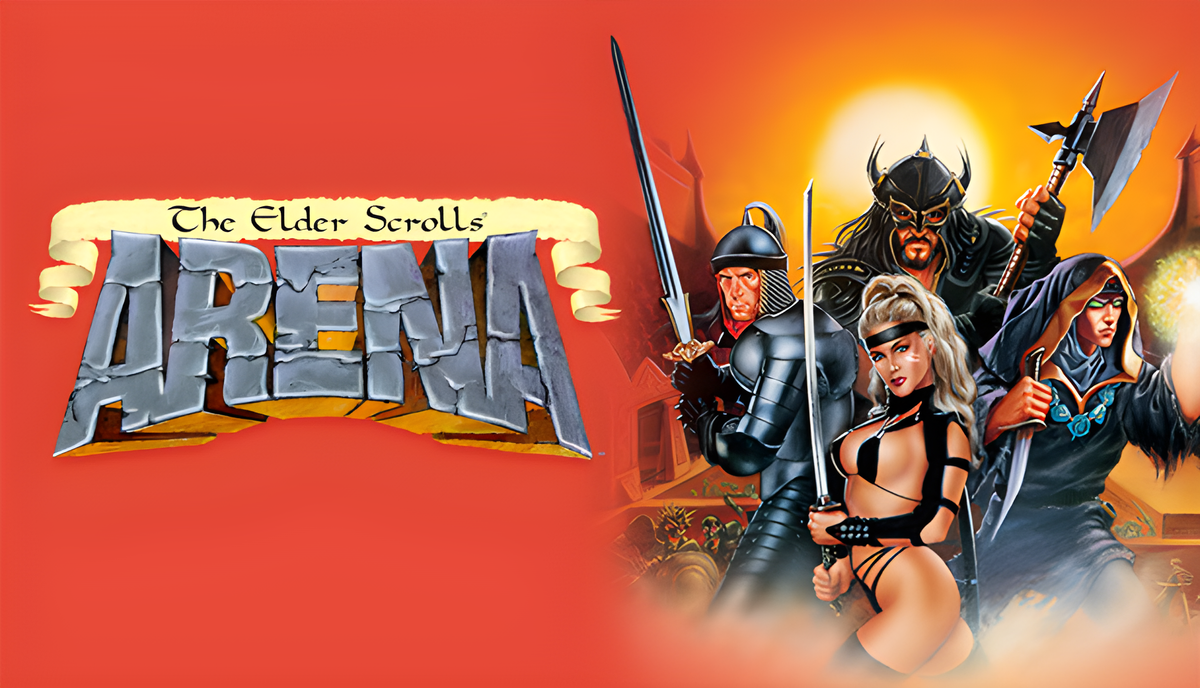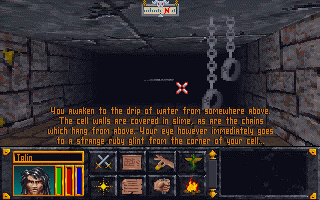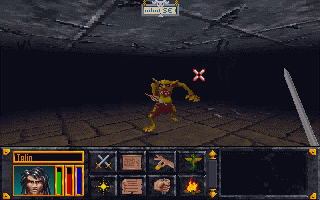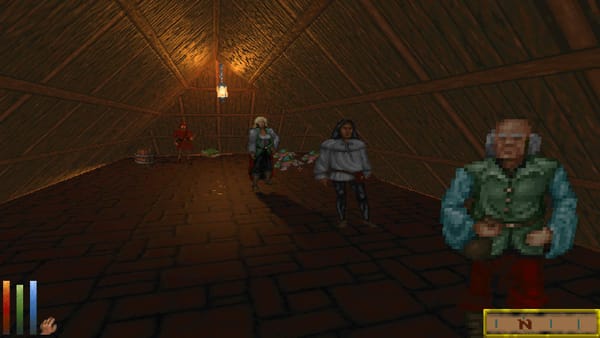An Introduction to Arena and the Escape from the Imperial Dungeons
The story of the Eternal Champion begins.

The Elder Scrolls series began in 1994 with its humble debut title, Arena. In my opinion, it wasn’t until the second entry, Daggerfall in 1996, that the series truly hit its stride and began to become the Elder Scrolls we all love. Having said that, Arena has dungeon-crawling charms of its own. There’s a certain Zen to be found in its simple systems, sprawling corridors and hordes of traditional beasties, and an undeniable satisfaction when you get hit with that satisfying level-up tune or secure that next piece of the Staff of Chaos. While it will amount to little more than a historical curio for casuals, hardcore fans will recognize iconic locations and artifacts from the series like Labyrinthian and the Ebony Blade.
For those who might want to give the game a whirl themselves, I’m including some installation and modding recommendations. If you aren’t interested, skip down to “The Elder Scrolls: Arena” section. Without further preamble, let’s get into it!
Installation
Arena is free software, available via Steam, Gog, or Bethesda’s own website. However, the best way to play the game is with the excellent Arena Setup utility. This handy installer comes packaged with a pre-configured Dosbox to run on modern operating systems. However, we can do a few simple tweaks, most of them recommended in the ReadMe file included with Arena Setup, to make the experience even better.
- Locate the file called DosBox.conf in the Arena install directory.
- Open the file with a text editor like Notepad to edit it.
- If you want the game to run in full screen mode, change the line that reads “fullscreen=false” to “fullscreen=true”.
- Change the line that reads “output=Surface” to “output=opengl” or “output=ddraw”.
- If running in full screen. on the line that reads “fullresolution=original”, replace “original” with your monitor resolution (1920×1080 for most people).
- Under the [render] category, change the line that reads “scaler=normal2x” to read “scaler=normal3x”. This upscales the graphics just a little bit more than the default.
- Under the [cpu] section, make the “cycles=fixed 20000” line read “cycles=fixed 30000”. I found the game ran somewhat slow with the default setting, increasing this cycle speed makes the game run butter smooth, with some very minor graphical quirks (bartenders will clean their glasses INCREDIBLY fast and aggressively). If things are still a little choppy, you can change the setting to “cycles=max” to run at top speed, although be mindful that this will make the combat very fast and can make it easy to miss things like the ambient text that pops up in dungeons.
- Save your changes and close the file.
With these changes, the game will open and run smoothly in full screen and scale to your monitor resolution without mucking up your desktop. Now, on to mods.
Modding
The Elder Scrolls series boasts one of the most prolific modding communities in gaming history. However, due to engine limitations and a general lack of interest, mod choices for Arena are limited. There are however, a few minor additions that are worthwhile.
- TES Arena Title Screen Fix by PerPhenom + OpeningFix by Gehrich + TES Arena IntroFix by ArtInPinkerton: These mods fix minor visual errors, typos, and lore inconsistencies present in the opening screens of Arena.
- Speech – No Hiss by Bevier + Sound Patch by Corsafire1: These mods are great used in conjunction. The former removes the distracting hissing sounds present in the dialogue, and the latter removes some very loud and unnecessary clicking sounds when navigating the game menus.
- TES Arena ReFonted by ArtInPinkerton: This mod replaces the very low-resolution fonts present in the game with a new font that is much easier to read.
- TES Arena Remapped by ArtInPinkerton: The control scheme of Arena is antiquated, and it isn’t possible to rebind keys in-game. This remaps the controls of the game to be more-or-less consistent with the controls of later games in the series, the most noticeable change being the switch from the arrow keys to WASD for movement. Because of DosBOX limitations, rebinding the keys isn’t context sensitive, so the rebinds will stick even when typing, creating a jumbled mess. However, typing isn’t terribly frequent in the game, and the developer has included a function in which you can hold the ALT key to switch back to the standard bindings and type normally. It’s a little awkward at first, but well worth the tradeoff for better controls during the actual gameplay.
- Eye of Nocturnal by AVGVSTA: This mod expands the draw distance of the game far beyond what it is normally capable of, enabling you to see details in the cities and dungeons from much further away. I’d consider this optional as some may view this as “cheating” at least as far as the dungeons go, and could theoretically cause weird visual behaviors depending on your configuration settings. I will not be using it for this playthrough.

The Elder Scrolls: Arena
Upon launching the game, we’re greeted with some introductory text which introduces us to the setting of Tamriel (Elvish for “Dawn’s Beauty”) for the first time. The land has been ravaged by war and conflict for so long, that people have begun to call it “the Arena”. The game was originally going to be based around gladiatorial combat, but changed over time into the globe-trotting RPG it is today. The name stuck however, and this lore explanation was created for some context.
Starting a new game opens with a brief cutscene. Emperor Uriel Septim VII and Talin Warhaft, the leader of the Imperial Guard, are summoned by Jagar Tharn, Imperial Battlemage of the Empire, on “rumors of treachery”. In a truly unexpected plot twist, the emperor is betrayed. He and the general are captured and whisked away to a pocket dimension created by Tharn. The other Imperial Guards are slain or captured and replaced with Tharn’s monstrous servants. The wicked mage slays his apprentice Ria Silmane before she can warn anyone of his deceit. He then assumes the identity of the emperor and takes the throne for himself.

Character Creation
Creating a character in Arena is much simpler than the following games in the series. There are no skills to pick from and there are no custom classes. The first step is picking a class to play. You can pick from the class list or instead answer a series of questions, and the game suggests a class for you based on your answers. Some of these questions will be familiar to those who have played Daggerfall or Morrowind, where they were reused. I answered the questions for fun and flavor, but ended up choosing my own class anyways, going with Spellsword. I’ve only played this game as either a Warrior or Knight, entirely non-magic classes. It makes sense to me that the hero destined to assemble and wield the Staff of Chaos would be a warrior of some kind, while also having some magic ability. Plus, it will be fun to try something different. Spellswords can’t wear plate armor which comprises many of the most overpowered artifacts in the game, so it will be an interesting challenge to do without them.
After picking a class, you choose a race, albeit indirectly, by choosing your home province.

Imperials, the standard humans of the Elder Scrolls are not available in Arena, so I chose a Breton of High Rock as my race.
After choosing your race, you roll stats, which are randomly generated with maximum starting rolls determined by your chosen race. You are also given a random number of bonus points to assign to any skill of your choice. I’m unsure of the exact correlation, but it seems that the lower your average roll, the more bonus points you are given. You can reroll these stats as many times as you want and can theoretically spend hours grinding for that optimal starting roll. I certainly wouldn’t lower myself to such shady tactics *cough*.
The final step of creation is choosing a face for your character, most of them are butt ugly.
A Note on Canon
The lore for Arena is rather sparse, and much like the other entries in the series, there is no true canon character. However, Arena is unique in that it names the hero in the introduction in the game manual, “Talin.” This matter is heavily disputed amongst lore enthusiasts, as Talin is the name of the general who is captured alongside the emperor, which IS canon. The circumstances of this confusion are a bit complicated. Much like the very premise of the game, the story and characters of the game were changed throughout development. At one point, the game was supposed to be party based, with Talin being a potential member of the party. In this iteration, the character of the Imperial Guard Talin Warhaft, father of the party member Talin, was much more involved in the story, taking on a mentor sort of role for the characters. Some of the character creation questions left in the final game still allude to this Talin being your father. References to this character and his significance were cut, others were left in. It’s entirely possible that the writers for the game just liked this name and wanted to leave it in in some capacity. For more details check the UESP pages on Talin, Talin Warhaft, and The Eternal Champion.
The most sensible explanation we are left with is that Talin is both the name of the player character, and the name of the general who is his father or adopted father. It’s not a perfect explanation, but it’s the closest to a sensible canon we really have. With the details we are provided, as well as a few I created to bridge some gaps, I wrote a brief backstory for the player character.
Talin was born in 3E 370 in a small High Rock village to unknown parents. At a young age, he came into the care of Talin Warhaft of the Imperial Guard, first as a ward, later as an adopted son, and would eventually take that name for himself. From adolescence, he began living in the Imperial Palace, but not as a pampered noble. He was groomed to eventually join the Guard himself, working the fields and stables, learning history, tactics, and decorum amongst the young nobility, and practicing arms and warfare under the tutelage of the venerable and stern Armsmaster Festil.
At the age of thirteen, Talin also began learning the ways of magic from Ria Silmane, apprentice of Jagar Tharn. The two would become fast friends in time. At eighteen, Talin was officially recognized as a Spellsword in the service of the Imperial Guard. Before too long, he would be drawn into the events that would come to be known as the Imperial Simulacrum.
To clarify, this backstory is not official, but one I’ve created for the purposes of this run to explain the circumstances by which Talin joined the Imperial Guard and was drawn into these events. With all that out of the way, the journey finally begins.

Escape from the Imperial Dungeons
Before gameplay starts, Talin is greeted by the ghost of Ria Silmane, the former apprentice of Jagar Tharn. She will serve as the principal quest giver of the story and his guide throughout the adventure. She explains to him what we already know, the Emperor has been betrayed and Tharn has assumed the throne is his guise. Having seen him as little threat, Tharn has left Talin to die in the Imperial Prison instead of killing him outright. Talin is the only one left alive who knows the truth and must escape from the prison and begin the quest to stop Jagar Tharn. Her powers waning, Ria tells the hero of a shift gate that will allow him to exit the prison, hidden somewhere in its depths, and that she will visit him again in his dreams.

Talin awakens in a cell in the Imperial Dungeons within the sewers. The back of his head is crusted with dried blood, and some minutes pass before his eyes adjust to the gloom. As instructed by Ria, he finds a ruby key in a forgotten corner of the cell, buried under a mound of dust. He quickly tries the key in the lock of the cell door, which opens with an ominously loud screech. Exiting the cell, Talin stumbles over a recumbent form in the dark. Pulling a torch from a nearby sconce, he investigates and discovers the recently slain corpse of a prison guard, the gleaming tang of a half-sheathed longsword clutched in his hands. After wresting the weapon from the dead guard’s clutches, Talin takes a couple test swings. Satisfied with the weight and balance, a subtle smile crosses Talin’s lips. With steel in his hand and determination in his step, Talin plunges into the darkness.

After having found a longsword in a stroke of luck, Talin begins to explore the sewers. The opening dungeon is riddled with goblins and rats, and he’s thrust into combat before too long.
Combat in Arena is not the most glamorous affair. You must hold the right mouse button and move your mouse in different directions for different types of attacks. Moving the mouse forward thrusts, backwards chops, and moving the mouse left and right produces horizontal swings in either direction. They do different damage amounts, but I don’t see much point in overthinking the attack types, I simply charge forward and flail my mouse around to attack as fast as possible.

As a Spellsword, Talin also started with a couple spells, one for healing and one for damage. You start the game off with very little in the way of spell points, so I save my limited mana reserves for healing spells when I need them throughout the dungeon.
One of Arena’s most notable quality of life features for its time is an automap feature. Rather than many games of the era, you don’t have to draw your own map, the in-game map fills out automatically as you explore a dungeon. This is handy since many of the dungeons, including this one, are winding configurations of corridors and are often interconnected with canals you must swim through to access different areas. One frustrating oversight is the inability to zoom out to see the entire map, there is a lot of panning around the map involved in navigation.

During his explorations throughout the Imperial Dungeons, Talin advances to level four, increasing his max endurance, intelligence, and agility in the process. He also acquires an amulet and torc of unknown, but clearly high-quality make.
After what seems like hours of stumbling in the dark, Talin encounters the shimmering shift gate Ria told him about. Battered, bloodied, and soaked to the bone after several swims through the filthy sewer canals, relief washes over Talin like a warm Summer breeze. Yet, uncertainty stays his steps. Was this really the exit? Was the spirit of Ria truly to be trusted, or yet another trick orchestrated by Tharn. Even so, what other choice did he have? Steeling himself, Talin steps through the portal.



